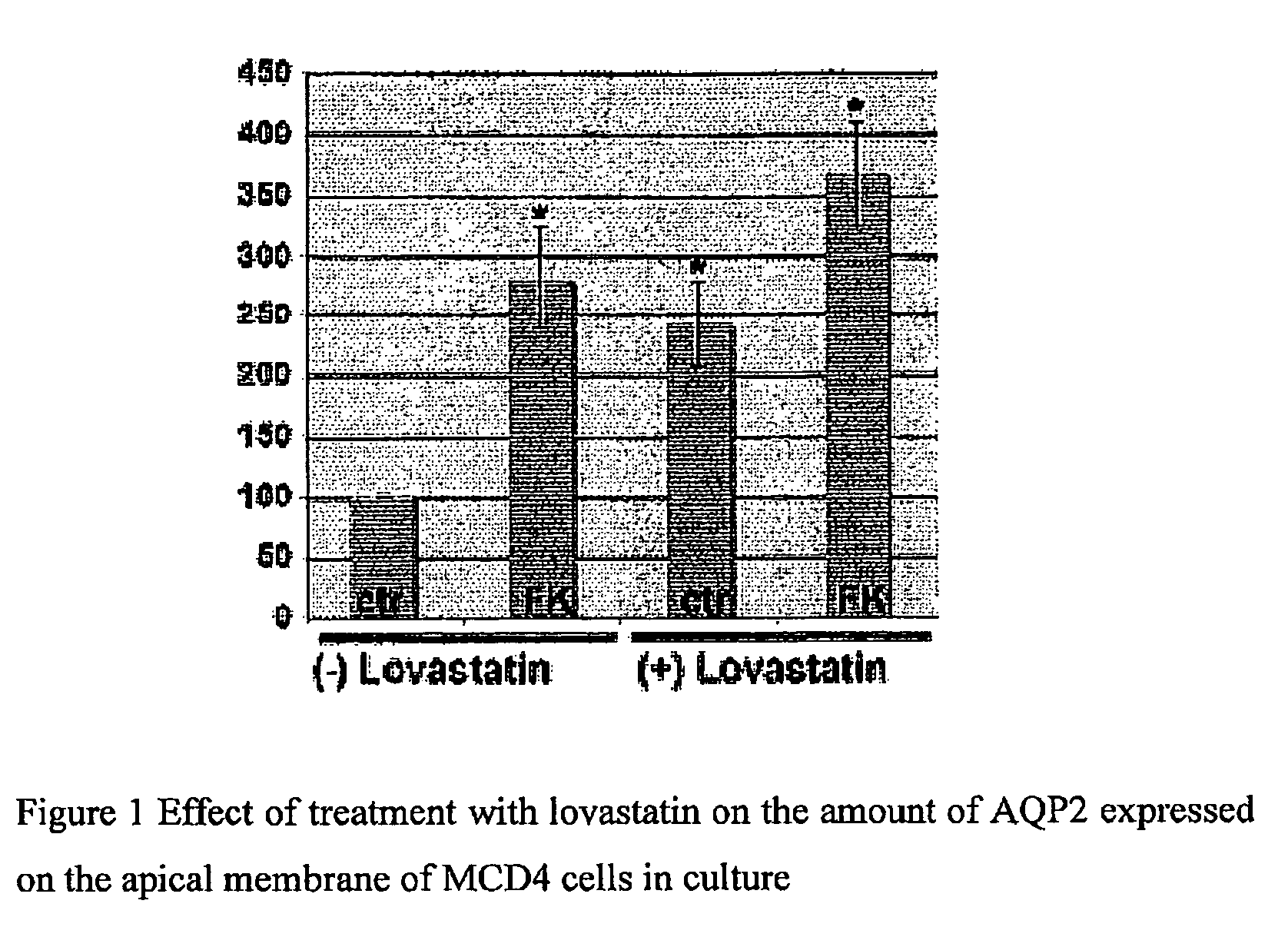Method of treatment of nephrogenic diabetes insipidus
a nephrogenic diabetes and xlinked type technology, applied in the field of nephrogenic diabetes insipidus treatment, can solve the problems of no real cure for ndi, serious side effects, and constant danger of dehydration and cardiovascular failure of the person affected, and achieve the effect of reducing the excess loss of urin
- Summary
- Abstract
- Description
- Claims
- Application Information
AI Technical Summary
Benefits of technology
Problems solved by technology
Method used
Image
Examples
example 1
In Vitro Evaluation of the Depletion of Cholesterol on the Accumulation of AQP2 on the Plasmatic Membrane
[0029]The MCD4 cells, which are in culture and derive from main cells of the renal collecting duct, were treated experimentally with lovastatin. In the cell model, as in the renal tubule in vivo, the presence of AQP2 on the membrane depends on the presence of vasopressin.
[0030]In MCD4 cells in the absence of lovastatin in the culture medium (-Lovastatin) and in control (ctr) conditions, the AQP2 is stored in intracellular vesicles. When the levels of cAMP are increased via the use of forskolin (FK) 10−5 M for 20 min, the AQP2 is shifted by exocytosis to the apical membrane of the same cells. The FK mimes the effect of the vasopressin in in vitro experiments. The same phenomenon occurs in the tubule in vivo following release into the circulation of vasopressin. In the presence of 5 μM lovastatin in the culture medium for 72 h (+Lovastatin) the control (ctr) cells accumulate a cons...
example 2
In Vivo Evaluation of the Effect of Administration of Fluvastatin on the Amount of AQP2 Urine Expressed on the Apical Membrane
[0034]Adult male mice C56BL6 were treated in acute phase with a dose equal to 10 mg / Kg of body weight of fluvastatin dissolved in sterile physiological solution. The method of administration was intravenous injection via the caudal vein. An identical number of mice were injected with physiological solution only and used as a control. The mice were kept for the following hours with water and food ad libitum. Once 6 hours had elapsed from the infusion, the mice were sacrificed, the kidneys rapidly removed, fixed, embedded and sectioned under cryomicrotome to obtain semi-fine sections of 5 μm on which AQP2 immunolocalization experiments were performed. The interval of 6 hours between the pharmacological treatment and the sacrifice was chosen on the basis of the indications resulting from the in vitro experiments.
[0035]With respect to the control condition, in wh...
PUM
| Property | Measurement | Unit |
|---|---|---|
| body weight | aaaaa | aaaaa |
| volumes | aaaaa | aaaaa |
| volume | aaaaa | aaaaa |
Abstract
Description
Claims
Application Information
 Login to View More
Login to View More - R&D
- Intellectual Property
- Life Sciences
- Materials
- Tech Scout
- Unparalleled Data Quality
- Higher Quality Content
- 60% Fewer Hallucinations
Browse by: Latest US Patents, China's latest patents, Technical Efficacy Thesaurus, Application Domain, Technology Topic, Popular Technical Reports.
© 2025 PatSnap. All rights reserved.Legal|Privacy policy|Modern Slavery Act Transparency Statement|Sitemap|About US| Contact US: help@patsnap.com

